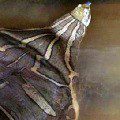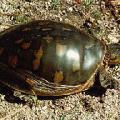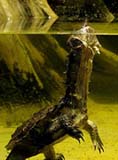
narrow-headed tortoise
The Indian narrow-headed tortoise (Chitra indica) is a very large species of narrow-headed tortoise that has existed for over 200 million years. Representatives of this species live mainly in India, Pakistan and other countries of the Indochinese Peninsula. The shell of the narrow-headed Indian tortoise is rounded, decorated with an intricate mesh pattern. Its size in diameter is usually 80-115 cm. The narrow small head of the turtle, which gave the name to the genus, is decorated with dark longitudinal stripes. The small eyes of the animal are shifted forward and upward.
Other names
Chitra indica, River soft-bodied.
Habitat
Indian narrow-headed tortoises are distributed mainly in the territories of the Indochinese Peninsula – in northern India, Bangladesh, Pakistan, and further east, up to Vietnam. Since representatives of this species of turtles prefer freshwater reservoirs and sandbars on their banks, they live in the basins of the Sutlej, Mahandi, Godavari, Ganges and Indus rivers.
Although the Indian narrow-headed tortoises prefer sandy-bottomed freshwater bodies of water, mostly fast, clean and full-flowing rivers, they can also live in salty waters. Chitra indica is primarily aquatic and only comes to the surface during the breeding season to lay eggs. At the same time, turtles are afraid to move far from the water.
But the pollution and alteration of rivers, including sand mining, the construction of reservoirs and dams, has taken a toll on freshwater turtle populations. Therefore, Indian narrow-headed tortoises are now often seen not in clean and fresh river waters, but in reservoirs or in the lower reaches of rivers.
Description
The Indian narrow-headed tortoise (Chitra Indica) is not only spectacular, but also an ancient tortoise. Even in the Pliocene (5-2 million years BC) deposits of the Indian hills of Sivalik, fossil remains of the genus Chitra were found.
Representatives of this species belong to the family of soft-bodied turtles adapted to an aquatic lifestyle, which determines most of their distinguishing features. That is why the bony shell of Indian narrow-headed tortoises does not have a hard horny cover – it is covered with soft skin. On their carapace (spinal shield) there are only ossified central elements surrounded by a wide border of cartilage. On the plastron (abdominal shield) in the middle there is also an extensive cartilaginous field. Like all three-clawed turtles, in the Indian narrow-headed turtles, the carapace and plastron are movably connected by a soft ligament. Their shell is almost round and strongly flattened, very large – from 80 to 115 cm in diameter. The limbs are flipper-shaped, short, and the membranes on them are well developed. At the ends of the paws, a formidable weapon is very sharp claws, which these turtles love and know how to use.
In order to breathe underwater without floating to the surface, the Indian narrow-headed turtles have a movable long proboscis on the front of the muzzle. At its end, if necessary, the nostrils open.
Perhaps the most important feature of this type of turtle is the presence of not only air type of breathing, but also water. Cutaneous respiration occurs due to the skin supplied with a large number of capillaries. The main organ of such breathing is the pharynx, inside which there are many villous outgrowths of the mucous membrane, which in function resemble gills. Since the absorption of oxygen comes directly from the water, Indian narrow-headed tortoises can spend a lot of time at the bottom of fresh water.
Her eyes are directed straight ahead and set wide apart. The horny jaws of the turtle are covered with thick leathery outgrowths (kind of lips).
The color of these turtles is rather nondescript. The main background is olive-gray, and the carapace (back shield) is covered with irregular light spots similar to hieroglyphs, surrounded by a dark border. This unusual pattern also extends to the turtle’s very long neck and narrow, short head.
The peak of activity of these turtles falls on the daytime, at night they are inactive.
Food
Unlike land turtles, which eat plant foods, freshwater turtles are mostly predators. The Indian narrow-headed tortoise is no exception. Under natural conditions, it feeds mainly on fish and other aquatic live food – crabs, shrimps and various mollusks. In addition, the large size of the turtles allows them to attack the chicks of waterfowl or small mammals swimming across the pond. To catch fish or other food swimming past it, the turtle throws its head sharply on a long neck and at the same time captures food with its jaws.
Reproduction
Indian narrow-headed tortoises usually lead a solitary lifestyle. They seek companies of their own kind only during the mating season. It was then that the male turtles arrange fights for the right to mate with the female, during which they chase the enemy and bite him. The winner courts the female, trying to get her to stop and take a comfortable mating position. Indian narrow-headed tortoises of either sex have a special recess on the plastron (abdominal shield) designed to improve fixation during this process. Mating itself takes place right in the water, while swimming.
The incubation period for these turtles lasts 60-70 days. Along with some sea turtles, Indian narrow-headed turtles have a record for the number of eggs – there can be over 150 in a clutch (although the average number is 50). Before laying eggs, females dig a pitcher-shaped hole with their hind legs. Then they cover it with sand already together with the laid masonry, tamping it from above with the help of blows with a plastron. The eggs themselves of these turtles are white and covered with a hard calcareous shell. Oddly enough, turtles completely lack maternal instinct. After laying eggs, females lose all interest in them and do not show the slightest concern for offspring.
Content
 Keeping any soft-bodied turtles (and Indian narrow-headed turtles among them) is a rather difficult task. First of all, they need a large aquarium. Decorative aquarium vegetation should not be carried away. but for decoration, you can use a background false wall, as well as the roots of marsh plants, washed driftwood, driftwood or non-sharp driftwood. The optimum water temperature in an aquarium containing an Indian narrow-headed tortoise is approximately 28-30 degrees. The water level should not be high, but the turtle should be able to submerge completely.
Keeping any soft-bodied turtles (and Indian narrow-headed turtles among them) is a rather difficult task. First of all, they need a large aquarium. Decorative aquarium vegetation should not be carried away. but for decoration, you can use a background false wall, as well as the roots of marsh plants, washed driftwood, driftwood or non-sharp driftwood. The optimum water temperature in an aquarium containing an Indian narrow-headed tortoise is approximately 28-30 degrees. The water level should not be high, but the turtle should be able to submerge completely.
Soil for soft-bodied turtles is necessary. Since all soft-bodied turtles do not have a hard shell, sharp stones and quartz sand are completely excluded in the aquarium. Some sources advise using washed or sterilized river sand with small grains of sand with a diameter of about 0 to 5 mm as a primer. But in practice, sand is usually clogged into the delicate folds of the skin of Indian narrow-headed tortoises, so natural silt is an ideal ground for them. Unfortunately, it is difficult to imitate in the home aquarium. The ground level should be about the size of a turtle.
Also, sand or mud needs to be washed out from time to time to prevent fungal diseases from developing in your soft-bodied turtle. Dead fish from the aquarium also need to be removed on time.
To simplify the maintenance of an aquarium with soil, a powerful water filtration system is built into it. It is based on special bottom filters installed under sand or silt and pumping water through the soil to clean it. Naturally, the more powerful the filtration, the better: the minimum throughput of the bottom filter is at least 20-30 liters per minute. There is one caveat: although the water in the aquarium is constantly filtered, it is still necessary to change it every 10-14 days. Unfortunately, aquatic turtles produce a lot of garbage, so it is most convenient to use a powerful centrifuge pump in the aquarium.
If you want to breed Indian tortoises in captivity, switch from an aquarium to an aquaterrarium for a while so that your tortoise has a place to lay eggs.
However, this species is highly discouraged for breeding and general home maintenance, as it bites very fiercely and is poorly tamed.
Additionally
 On the IUCN Red List of Threatened Animals, the Chitra Indica species is in the Endangered (EN) category. This is due to the fact that turtle meat is very tasty, and representatives of this species were often caught for eating. Even during the journey of Christopher Columbus across the Atlantic Ocean, sailors made “live canned food” from “living stones”. To do this, the turtles were caught and put on the deck, turning them on their backs. They were covered with a tent from the sun, and they traveled with Columbus as a supply of food.
On the IUCN Red List of Threatened Animals, the Chitra Indica species is in the Endangered (EN) category. This is due to the fact that turtle meat is very tasty, and representatives of this species were often caught for eating. Even during the journey of Christopher Columbus across the Atlantic Ocean, sailors made “live canned food” from “living stones”. To do this, the turtles were caught and put on the deck, turning them on their backs. They were covered with a tent from the sun, and they traveled with Columbus as a supply of food.
To this day, people continue to treat turtles as consumers, catching them in huge quantities for food – no longer out of vital necessity, but as a delicacy.
In addition, due to pollution and alteration of rivers, in particular sand mining and the construction of reservoirs or dams, populations of Indian narrow-headed tortoises have decreased dramatically. In some countries, the authorities tried to relocate freshwater turtles to other places, but they failed – the turtles did not take root in the new territory for natural reasons.
Sources of
http://pitomcy-almaty.ucoz.kz/
http://redturtles.name/
http://www.cherepahi.ru/
http://webmvc.com/
http://mypets.by/
http://www.zooall.info/
http://www.enci.ru/
Classification
Kingdom: Animals (Animalia)
Type: Chordata
Subtype: Vertebrates (Vertebrata)
Class: Reptiles (Reptilia)
Order: Turtles (Testudines)
Suborder: Hidden-necked turtles (Cryptodira)
Superfamily: Softshell turtles (Trionychoidea)
Family: Three-clawed turtles (Trionychidae)
Genus: Narrow-headed turtles (Chitra)
Species: Indian narrow-headed tortoise (Chitra indica)





